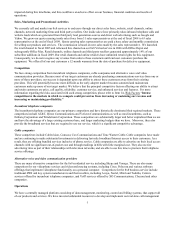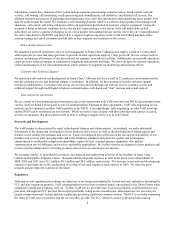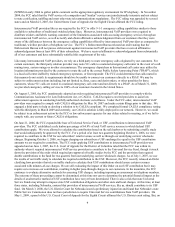8x8 2009 Annual Report Download - page 18
Download and view the complete annual report
Please find page 18 of the 2009 8x8 annual report below. You can navigate through the pages in the report by either clicking on the pages listed below, or by using the keyword search tool below to find specific information within the annual report.16
Intense competition in the markets in which we compete could prevent us from increasing or sustaining our revenue
and increasing or maintaining profitability.
The telecommunications industry is highly competitive. We face intense competition from traditional telephone companies,
wireless companies, cable companies, competitive local exchange carriers, alternative voice communication providers and
independent VoIP providers.
Most of our current and potential competitors have longer operating histories, significantly greater resources and name
recognition, and a larger base of customers than we have. As a result, these competitors may have greater credibility with our
existing and potential customers. They also may be able to adopt more aggressive pricing policies and devote greater resources
to the development, promotion and sale of their products than we can to ours. Our competitors may also offer bundled service
arrangements offering a more complete product despite the technical merits or advantages of our products. Competition could
decrease our prices, reduce our sales, lower our gross profits or decrease our market share.
Most traditional wireline and wireless telephone service providers and cable companies are substantially larger and better
capitalized than we are and have the advantage of a large, existing customer base. Because most of our target customers are
already purchasing communications services from one or more of these providers, our success is dependent upon our ability to
attract target customers away from their existing providers. Until recently, our target market has been composed largely of
early adopters, or people who tend to seek out new technologies and services. Attracting customers away from their existing
providers will become more difficult as the early adopter market becomes saturated and mainstream customers make up more
of our target market. In addition, these competitors could focus their substantial financial resources to develop competing
technology that may be more attractive to potential customers than what we offer. Our competitors’ financial resources may
allow them to offer services at prices below cost or even free in order to maintain and gain market share or otherwise improve
their competitive positions. Our competitors could also use their greater financial resources to offer VoIP services with more
attractive service packages that include on-site installation and more robust customer service. In addition, because of the other
services our competitors provide, they may choose to offer VoIP services as part of a bundle that includes other products, such
as video, high speed Internet access and wireless telephone service, which we do not offer. This bundle may enable our
competitors to offer VoIP service at prices we may not be able to compete with, to offer a single bill for multiple services, or to
offer functionality that integrates VoIP service with their other offerings, any of which may be more desirable to consumers.
Any of these competitive factors could make it more difficult for us to attract and retain customers or could cause us to lower
our prices in order to compete and reduce our market share and revenues.
We also compete against established alternative voice communication providers and face competition from other large, well-
capitalized Internet companies that have recently launched or plan to launch VoIP-enabled services. In addition, we compete
with independent VoIP service providers. Some of these service providers may choose to sacrifice revenue in order to gain
market share by offering their services at lower prices or free. In order to compete with such service providers, we may have to
significantly reduce our prices, which would delay or prevent our profitability.
We also are subject to the risk that new technologies may be developed that are able to deliver competing voice services at
lower prices, better or more conveniently. Future competition from new technologies could have a material adverse effect on
our growth and operating results.
Given the significant price competition in the markets for our products, we are at a significant disadvantage compared to our
competitors, many of whom have substantially greater resources, and therefore may be better able to withstand an extended
period of downward pricing pressure. The adverse impact of a shortfall in our revenues may be magnified by our inability to
adjust spending to compensate for such shortfall. Announcements by our competitors or us of new products and technologies
could cause customers to defer purchases of our existing products, which also could have a material adverse effect on our
business, financial condition or operating results.
We depend on contract manufacturers to manufacture substantially all of our products, and any delay or interruption
in manufacturing by these contract manufacturers would result in delayed or reduced shipments to our customers and
may harm our business.
We do not have long-term purchase agreements with our contract manufacturers and we depend on a concentrated group of
contract manufacturers for a substantial portion of manufacturing our products. There can be no assurance that our contract
manufacturers will be able or willing to reliably manufacture our products, in volumes, on a cost-effective basis or in a timely
manner. If we cannot compete effectively for the business of these contract manufacturers, or if any of the contract
manufacturers experience financial or other difficulties in their businesses, our revenue and our business could be adversely
























